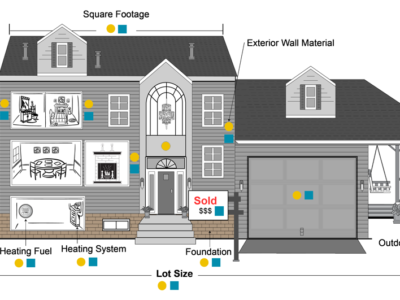HUGE
New Addition to California’s Infill Housing Bill Could Transform the State’s Land Use

If there is one journalistic phrase I despise, it is “game-changer.” Everything seems to be a game-changer, no matter how small. But amendments just approved by the California State Senate for SB 50, Scott Wiener’s controversial bill upzoning lots near transit could be, well, a game-changer:
On Wednesday, a key committee signed off on Senate Bill 50 — San Francisco Sen. Scott Wiener’s bill to allow denser, taller housing around transit and in communities with lots of jobs. As part of the negotiations, Wiener agreed to merge his proposal with Senate Bill 4 by Sen. Mike McGuire (D-Healdsburg) and the result includes one very big change: Single-family houses could be converted to four-unit buildings, by right, anywhere in the state.
That is, a property owner could subdivide or remodel a house to turn it into four apartments. Or a developer could build a fourplex on a vacant single-family lot. The proposal wouldn’t allow people to demolish a house and build a new fourplex on the property, however.
Put another way, if these amendments pass, then California will have just outlawed single-family housing throughout the state. And it points to a potential way out of the NIMBY/density problem.

Neighbors dread the prospect of living next to, well, YUGE towers of apartments — they say they are concerned about privacy, and shadows, and “neighborhood character,” with all the classist and racial implications of that loaded phrase. But increasing density by turning a house into a quadruplex seems less…yuge. It doesn’t seem so out of scale. It doesn’t evoke images of the Robert Taylor Homes or Stateway Gardens complexes in Chicago. Little wonder that when, a few months ago, Minneapolis increased the density of its zoning code, it did so not by building up, but rather by allowing triplexes in formerly single-family zones. It was controversial, but far less so than building up.
SB 50 has a long way to go before it becomes law: Wiener and his supporters are engaged in intense negotiations just to get it through the Senate, and then it must go to the Assembly, etc. etc. You know the drill. Even in Minneapolis, the city council backed off allowing quadruplexes by right and went down to triplexes. But if just this provision passes, it would be the most significant land use reform in California since the enactment of CEQA. And that is yuge.
Reader Comments
4 Replies to “HUGE”
Comments are closed.






Prof. Zasloff, the new American Lung Association report:
“The State of the Air Is Worsening as Climate Impacts Multiply
Many US cities have poor air, according to the American Lung Association”
proves that California is not solving our air pollution and global warming problems with the greatest sense of urgency because atmospheric CO2 levels continue to be out of control.
I most sincerely hope and pray that you and all your UC academic colleagues shall immediately begin teaching and motivating our newest generation of academics to communicate with peoples around the world far better than older generations have been failing to do because the ALA report proves global warming is out of control due to failures to communicate by academics so far.
https://www.sierraclub.org/sierra/state-air-worsening-climate-impacts-multiply
I totally support denser housing in CA, and believe we should outlaw building anything, anywhere on existing green fields.
But I take exception to your classifying the concern about “neighborhood character” as simply classist and racist. I happily live in a very racially diverse neighborhood in Oakland, and I’m very concerned about the prospect of every house on my block becoming a 4-plex. I’m not sure this even applies to my neighborhood, as we’re zoned for 2-units, not single-family, but an increase in height and density of that nature, absent parking and public trans options does not paint a good picture.
The cities that are building more infill housing, like SF and Oakland, aren’t beefing up public trans enough to accommodate this kind of density. They are defaulting to Uber and Lyft to take the pressure off car ownership, which is extremely classist and does nothing to help families.
Dense housing that accommodates a range of incomes, like they have in many parts of Europe, depends upon other social amenities that we simply don’t have in the U.S. Without amenities like three-bedroom units, fabulous public trans, affordable and ubiquitous child care, nearby great schools, shopping areas that do not require cars as CostCo, Home Depot, etc. do, parks, parks and more parks, this kind of housing can only work for young singles and couples–exactly the people that are buying in to this in SF and Oakland, Everyone else moves out to Antioch and Tracy, supporting the nightmare of sprawl development.
The history of racist housing laws, zoning and lending is a horrible legacy in our country, and our state, but let’s not throw the baby out with the bathwater.
Remember that excellent transit in turn depends on density and once we have enough riders per square mile, transit will be more practical, and single vehicle traffic congestion will tend to tip riders to public transit given the right incentives (for example, bus-only lanes not only speed up public transit, they clog up non-public transit).
As regards sustainable transit in general, note that a good resource is the Victoria Transport Policy Institute (www.vtpi.org).
The bill has just been declared dead for this (legislative) year.
Still worth thinking about:
“The bill’s focus on location near transit stops is clearly delusional given public transit’s plunging market share around the state. Recent studies suggest that incentives to develop high-density near transit stops has forced poorer, transit-oriented people to move further away, and even buy cars.” (JOEL KOTKIN & WENDELL COX, Densification Efforts Like SB50: Wrong Fix for CA’s Housing Problem, https://citywatchla.com/index.php/2016-01-01-13-17-00/los-angeles/17659-densification-efforts-like-sb50-wrong-fix-for-ca-s-housing-problem, 13 MAY 2019.)
So perhaps the bill should at least require a very high percentage of new apartments to be set aside for verified low income, low net worth residents. How high should that percentatge be? Who knows? 75-80%?